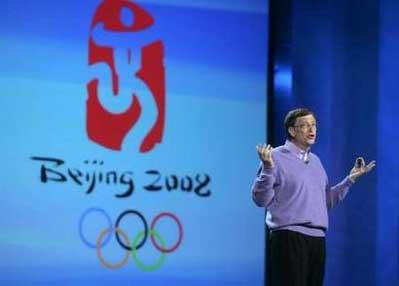YouTube - 比尔盖茨CES 2007 开幕演讲:无法阻挡的数字时代
晚上好,很高兴今天来到这里,见证一个个激动人心的时刻。过去几年里,很多梦想和希望都变成了现实。我第一次在CES上发表演讲是在1994年,那是很久以前的事情了。那时,windows 95刚刚推出,互联网还在起步阶段。
几年之后,我们进入了第一个"数字十年"。在这十年里,全球PC数量增至10亿台以上;宽带用户从无到有,目前已经超过2.5亿人;全球手机普及率超过 40%;照片也经历了从胶片到数字格式的转变,开始借助软件的力量;音乐行业面临着同样的转型,现在所有整理、选择和交流工作都可以通过软件完成。所有媒体和娱乐都将由软件驱动,这一趋势非常明显。第一个"数字十年"取得了巨大的成功。
当今的趋势是随时随地获取信息;让网站变得更加丰富,且同时支持消费者和企业活动;充分利用PC,进一步提升用户体验;以及充分实现定制化,帮助人们各取所需。10年之前,我曾经预见到一些发展趋势。我曾谈到过车载PC,现在我们已经拥有了福特SYNC;我曾谈到过掌上PC和基于智能手机,现在它们已经占据了大量的市场份额,而且借助于软件获得了更加丰富的应用;我们还将互联网电视会议的创意变为了现实,现在Media Room连接了超过100万名用户。
由以上事实可以看出,我们已经取得了长足的进步。第一个"数字十年"取得了巨大的成功,这得益于数千家公司的合作,其中包括硬件公司、软件应用公司、平台提供商、以及电影和电视游戏等内容制作公司。现在只是一个开始,没有什么能阻止我们更快、更深入地进入下一个"数字十年"。
在谈及下一个"数字十年"之前,我有一点要告诉大家,这是我最后一次在CES上发表主题演讲。到今年中期,也就是7月份,我将退出微软的日常管理,全心经营比尔及梅林达-盖茨基金会。这将是我17岁创立微软以来,首次退出公司日常管理。我不知道在微软的最后一天将如何渡过,因此,我请一些朋友帮我为此做准备。我们一起制作了一个小视频,请大家欣赏。
我认为这段视频并不能完全准确地表现可能要发生的事情,但它非常有趣。事实上,微软的权力交接工作非常顺利,雷?奥谢(Ray Ozzie)和克莱格?穆迪(Craig Mundie)逐步地承担了我的职责。当然,过渡期结束之后,我仍将选择几个项目,主题是软件的巨大力量,包括软件如何推动教育,以及软件如何推动全球医疗等等。
第二个"数字十年"
我们认为,第二个 "数字十年"的重点是将人们联系在一起,是以用户为中心。微软将提供一个平台,帮助用户打造应用。这些应用将不仅能在PC上运行,还能在互联网、手机、汽车和电视上运行。这些应用将充分发挥上述平台和互联网服务的优势。当我们谈到服务时,实际上包含了很多东西,例如地图服务、付费服务、好友列表、以及存储服务等等。这些服务将横跨工作和商业,就像当前的个人计算机一样。
很多重大进展都蕴藏着这些新型应用之中。我们还没有解决的问题,包括电视、阅读、医疗和教育的变革,都可能在这些因素的带动下迎刃而解。在这里,我要重点讨论三个要点,第一个是高清晰体验无处不在。
显示技术正变得越来越好,并不只是高清晰显示器,还包括可以在所有墙上投放图像的投影仪。我们未来可能不会把计算机放在桌子上,而是放在桌子里面。你可能需要在会议室开展协作,需要在起居室看新闻、玩游戏、以及整理照片。不管在哪里,投影仪都是一个不错的选择,它易于操作,容易改变,而且可供多人使用。
图像渲染的质量正变得越来越重要,不管是玩游戏,还是访问虚拟地球软件。3D环境将出现在更多网络体验之中,例如我们可能进入一个3D网络商店,或者在一个3D社交环境中与他人会面。基于这一原因,我们将推动高质量视频和高质量音频在更广的范围内普及。
我所谈论的第二个要点,是所有设备都将同服务连接在一起。受此影响,人们将会把获得最新软件、浏览器应用、以及自己的数据看作是理所当然。设备不同没有关系,地点差异也不将不再是问题。随着云存储的普及,人们连接设备、以及通过设备搜索将变得更加简单,同时信息共享也变得更加普遍。
事实上,当你拿起一个设备,并通过了身份认证,你就可以连接到自己的信息。也就是说,当你购买了一台新手机后,或者要借用他人的设备,都不会遭遇信息丢失或转储方面的麻烦。当你在移动之中时,仍然可以处理很多事情,例如整理自己的想法,回顾孩子成长的经历,以及通过系统查找与自己相关的信息等等。由此看来,数字记忆应用将变得更加普遍和重要。这些设备将了解你的"上下文",直到你的方位。
我所谈论的最后一个要点,同时也是最容易被人们低估的事物,是自然用户界面的作用。在第一个"数字十年",用户界面主要是键盘和鼠标。过去两年里,我们开始看到其它交互方式出现。我们开始谈论 Windows PC触摸屏和iPhone触摸屏。我们还看到Tellme语音功能集成在手机和福特SYNC之中,帮助用户与媒体或手机交互。
自然用户界面引发了强烈的市场反响,人们对于更加简单的信息导航方式非常感兴趣。因此,数字智能笔、触摸、图像识别等新型交互方式迅速普及,给用户带来了全新的体验。我们的目标是,只需坐在电视机前打几个手势,就可以完成想干的事情。现在距离这一目标还有很远的距离,因此我们只是出于起步阶段。要完成这一工作,首先要由软件行业提供一个平台,从而个人开发者无需从事过于复杂的工作。
微软的发展基础当然是Windows平台。我们将继续开发和创新这一平台,并将它变为真正的核心。对于PC行业来说,过去一年是令人难以置信的一年。2007年,全球PC销量同比增长13%。考虑到计算机用户群体已经十分庞大,这实在是一个不错的成绩。我们认为,未来一年全球PC销量将继续保持两位数百分比的增长。
一年之前,我们推出的Vista操作系统。到目前为止,全球已经有超过1亿人使用Vista。对于我们自己、以及软件和硬件合作伙伴来说,这是一个非常重要的里程碑。我们的很多合作伙伴都在PC中加入了新元素和新功能,特别是便携设备。很多产品都漂亮地令人难以想象,它们体积小巧,适合新的用途。
我们还拥有网络服务。过去一年里,网络服务取得了突飞猛进的发展。对于我们来说,我们的Windows Live服务已经拥有超过4亿名用户。在手机平台方面,Windows Mobile过去一年的用户人数超过了1000万,预计2008年将增加一倍。
